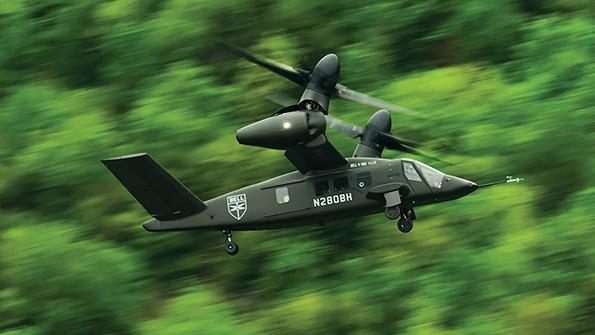
This initial FLRAA contract award opens the door to $70 billion in business for Bell.
The U.S. Army has selected Bell Textron to create its future rotorcraft fleet, announcing its choice to opt for the tiltrotor V-280 to replace its Sikorsky UH-60 Black Hawks in a move that will shape the future of America’s rotorcraft industrial base.
Despite the massive ramifications of the selection, the Dec. 5 announcement from the Army was an impromptu, subdued event signaling a potentially rough road ahead for the Future Long-Range Assault Aircraft (FLRAA) program in the event of a protest from the Sikorsky-Boeing team.
- The V-280 tiltrotor bests Sikorsky-Boeing’s Defiant X
- The Army says its schedule accounts for a possible protest
The award means Bell could receive up to $70 billion for the FLRAA fleet, depending on how many aircraft are ordered along with potential Foreign Military Sales. The acquisition contract covers a virtual prototype, with $232 million provided at the time of the award as part of a total package that could reach $1.3 billion, including options. Actual aircraft would follow in a possible $7.1 billion engineering and manufacturing development (EMD) contract, with that phase expected to be shorter thanks to the virtual prototyping effort.
“We are honored that the U.S. Army has selected the Bell V-280 Valor as its next-generation assault aircraft,” Scott C. Donnelly, Textron’s chairman and chief executive officer, said in a statement. “We intend to honor that trust by building a truly remarkable and transformational weapon system to meet the Army’s mission requirements. We are excited to play an important role in the future of Army Aviation.”
Bell’s V-280 Valor prototype beat out Sikorsky-Boeing’s Defiant X offering. The V-280 uses a tiltrotor, similar to the company’s V-22 Osprey, and will mark the Army’s first foray into tiltrotors. The Defiant X has a twin compound rotor and pusher propeller.
Army officials, in a short briefing outlining the contract, had few details about why the service selected the Bell offering. Douglas Bush, assistant secretary of the Army for acquisition, logistics and technology, said the V-280 offered the best value approach over a set of factors—without specifying those factors. Bell’s tiltrotor provides greater speed and range than the Defiant X, which is key as the Army postures itself to fight across longer ranges in the Pacific.
Bush said the Army has accounted for a potential protest from Sikorsky and Boeing in its timeline, but “whether that happens is up to the vendor in question.” A protest has long been expected because of the significant implications for the country’s helicopter industrial base.
“We remain confident Defiant X is the transformational aircraft the U.S. Army requires to accomplish its complex missions today and well into the future,” Sikorsky and Boeing said in a statement. “We will evaluate our next steps after reviewing feedback from the Army.”
During a May visit to Sikorsky’s Connecticut production facility, company President Paul Lemmo said Sikorsky’s parent company Lockheed Martin has rarely protested and, if it did, there would need to be a good reason. Sikorsky and Boeing “are the Army’s industrial base and . . . if we’re not selected, it’ll be a big deal,” he said.
“You don’t just file a protest because you’re upset that you lost,” Lemmo added. “There have to be legal grounds to think that something wasn’t followed appropriately. And, you know, we’ll look at the decision either way and decide at that time.”
Army Secretary Christine Wormuth told Aviation Week shortly before the contract announcement that she is confident the selection process has been robust and fair and that the chosen platform is the one that best serves the Army.
The Army’s investment in the V-280 gives Bell’s aircraft momentum as other U.S. services start to look at their own helicopter replacement programs as well as international efforts. The UK and the Netherlands have signed agreements with the U.S. for potential cooperation on future vertical lift programs, and six nations—France, Germany, Greece, Italy, the Netherlands and the UK—have signed a letter of intent for a Next-Generation Rotorcraft Capability.
The FLRAA award means the Army has finally selected a winner after a competition that began with the service selecting the two teams to participate in the 2014 Joint Multi-Role Technology Demonstration. Bell’s V-280 made its first flight in December 2017, and the Defiant flew about 16 months later. The V-280 design improves on issues that have troubled the V-22 fleet, such as stationary engines and rotating rotors and driveshafts and a straight wing as opposed to a forward-swept design. Bell’s program included 214 flight hours, some with Army test pilots, and encompassed low-speed agility and sling load demonstrations.
Bell and Sikorsky-Boeing are also competing for the Army’s Future Attack Reconnaissance Aircraft (FARA) program, which has been pushed back under the service’s current budget request. FARA’s EMD phase now is slated to start in fiscal 2025, shifting the developmental program’s end to fiscal 2032. Flight testing is expected in late 2023.





Comments